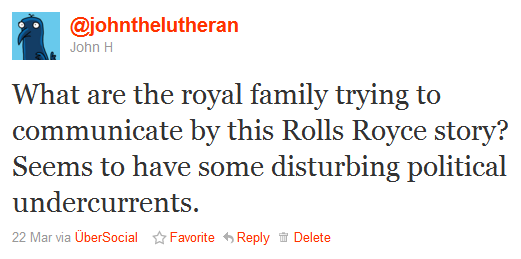The royal family seemed keen earlier this week to emphasise that the car in which Kate Middleton will travel to her wedding is the same Rolls Royce that was attacked in student protests.
No doubt this was intended as a heartwarming “good news” story, but something about it left me feeling uneasy, though I couldn’t quite put my finger on what at the time:
 Thinking about it further today, I think it’s the “Britain Can Take It!” tone of the coverage. We’re invited to think “Isn’t it great that those ghastly students haven’t succeeded in spoiling Kate’s special day?” At the very least, it’s hard not to see this as the royal family in some small way taking sides in a political issue.
Thinking about it further today, I think it’s the “Britain Can Take It!” tone of the coverage. We’re invited to think “Isn’t it great that those ghastly students haven’t succeeded in spoiling Kate’s special day?” At the very least, it’s hard not to see this as the royal family in some small way taking sides in a political issue.
(Not that I’m defending the students who attacked Charles and Camilla’s car. It was worse than a crime – it was a blunder, because it gave the media another excuse to focus on “violent students” rather than “violent police officers”.)
This particular story is only a straw in the wind, and I’ll cheerfully admit that I may be “over-reading” it. However, we do seem to be moving back towards a rhetoric of “the enemy within”: students, public sector workers (a.k.a. “enemies or enterprise”), lead-swinging benefit cheats, and so on.
In the light of that, it’ll be interesting to see how the phrase “we’re all in this together” develops over the next year or two. As coined by George Osborne, its avowed intent is to express how we are all one country, rich and poor, united against the common enemies of financial, economic and fiscal crisis, sharing its burdens fairly.
However, it won’t take much for it to become a slogan, not of a country united against external enemies, but of the middle and upper classes – “decent, respectable people” – united against internal enemies.
Which would at least have the benefit being more honest and accurate, given how this government has been acting to date.
Hello friendly comrade hedgehog
I’m now living between Bromley and Petts Wood – and would like to connect.
Please e-mail me and I’ll send you a phone number.
Best
John Courtneidge
One family with only a single car, and an old one at that? I bet Liz even uses it to pop down the local Lidl. What’s not for the media to love.
I’m as republican as they come, but I don’t see this as the royals setting out to “take sides.”
This debate has one “side” that chucks bricks at government-owned cars because they think this will stop planned library closures in Phillip Pullman’s home town, and there is another “side” that doesn’t chuck bricks at government-owned cars.
Under the circumstances I don’t see it as evidence of disgraceful bias to be pro- [O]ne’s own cars and by implication anti- the side that chucks bricks at the same.
As I said in my post, I’m against chucking bricks at cars, royal or otherwise. I’m also against hitting students with riot batons so hard that they have to have brain surgery.
I suppose my discomfort comes from this: there is an element of “us” and “them” to this story. A reassurance for “us” that “they” are not going to prevail. If the line between “us” and “them” is the line between those who chuck bricks at cars and those who don’t, then that’s one thing. But I suspect that for many in politics and the media, the line between “us” and “them” is the line between “respectable people” and “bolshie students” (even of the non-brick-chucking variety), and that that is only one of a number of such lines that also separate off “benefit scroungers”, “public sector fat cats” and so on. (Of course, the left can play the same game too, with “tax dodgers” and “bankers” cast in the role of “them”.)
It’s possible (!) that I was over-reading the specific story of the Rolls Royce. But the general point of the growth a more divisive rhetoric does, I think, still stand.